|
|
|
Sort Order |
|
|
|
Items / Page
|
|
|
|
|
|
|
| Srl | Item |
| 1 |
ID:
101326
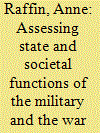

|
|
|
|
|
| Publication |
2011.
|
| Summary/Abstract |
Studies on the military in Vietnam today see a concurrence between the changing role of the army-its growing economic role as well as its role as a tool to control the Vietnamese population-and the changing economy and international environment. How do we make sense of this evolution and its impact on civil-military relations in terms of power relations and authority? This study seeks to provide an analytical framework that shows how the military is not a homogeneous entity but rather is made up of various groups that derive uneven benefits from the post-cold war situation. The author's contribution is primarily at the conceptual level, stressing the dynamics of power relations among the military, society, and state from a Weberian perspective. Doi moi, as an era of economic and social change, has redefined power relations. The author also emphasizes the generational and historical elements in civil-military relations that are specific to Vietnam.
|
|
|
|
|
|
|
|
|
|
|
|
|
|
|
|
| 2 |
ID:
101327


|
|
|
|
|
| Publication |
2011.
|
| Summary/Abstract |
During World War II the Canadian Army was a small cadre force augmented by citizen volunteers. It was a colonial institution, dependent on the British Army for doctrine and staff training. After the war, the army became involved in a lengthy struggle to define its concept of professionalism. Modernizers aimed for a well-educated officer corps that was integrated with other elites and able to influence national security policy. Traditionalists wished to preserve regimental traditions and leadership based on social class. Contention between these factions resulted in stalemate, with modern management undercut by internal politics. The result was the failure of professional norms in the 1993 Somalia operation. Subsequent reforms have put a modern "constabulary-realist" model of professionalism in place.
|
|
|
|
|
|
|
|
|
|
|
|
|
|
|
|
| 3 |
ID:
101329
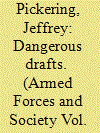

|
|
|
|
|
| Publication |
2011.
|
| Summary/Abstract |
Conscription has been claimed to both increase leaders' propensity to use military force abroad and constrain them from doing so. The author sheds new light on this longstanding controversy by presenting the first time-series, cross-national quantitative analysis of the impact that state military manpower systems (either conscription or volunteerism) have on the initiation of both traditional, belligerent military missions and "operations other than war" (OOTWs). Using negative binomial regression on 166 states from 1946 to 2001, the author finds that states with conscript militaries have a significantly higher propensity to use belligerent military force than states with volunteer armies. Countries that practice conscription are also more likely than countries with volunteer forces to launch a specific type of OOTW, military operations against nonstate actors such as rebels or terrorists. Neither form of military manpower system seems, however, to be significantly related to the initiation of humanitarian military operations.
|
|
|
|
|
|
|
|
|
|
|
|
|
|
|
|
| 4 |
ID:
101323
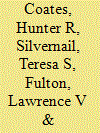

|
|
|
|
|
| Publication |
2010.
|
| Summary/Abstract |
The United States Army recently implemented a policy aimed at quelling a large-scale exodus of captains. This policy included the provision of a Menu of Incentives Program targeting officers in year groups 1999-2005. This study details the captain attrition problem, evaluates literature regarding retention options, analyzes the efficacy of the Army's interventions by branch and by year group, and draws conclusions regarding future incentives. Methods used include chi-square and odds ratios analysis. Results reflect high acceptance rates for year groups 1999-2003; however, officers in these year groups may have remained in the service without any additional incentives because they were logically beyond the initial decision point. Findings suggest that seniority, skill, and adequate incentive pay are important considerations for future incentive programs.
|
|
|
|
|
|
|
|
|
|
|
|
|
|
|
|
| 5 |
ID:
101325
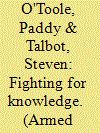

|
|
|
|
|
| Publication |
2011.
|
| Summary/Abstract |
Organizational Learning
Learning Systems
Learning Organization
Social Networks
Australia
Army
|
|
|
|
|
|
|
|
|
|
|
|
|
|
|
|
| 6 |
ID:
101331
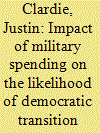

|
|
|
|
|
| Publication |
2011.
|
| Summary/Abstract |
Many countries complete tenuous transitions to democracy and must work to prevent an authoritarian reversal, which is often at the hands of the military. One of the most important tools the new government has in dealing with the military is the amount of money allocated to the military. This leads to the question, how does government military spending in post-transition democratic countries affect the chances of democratic transition failure? The extant literature provides two answers. The first is to increase military spending to placate the military; the second is to decrease military spending to weaken the military and address social welfare needs. The article tests these two hypotheses by examining democratic transitions from 1967 to 1999 using both logit and survival analysis methods. The results of the study provide robust support for the hypothesis that decreasing military spending decreases the likelihood of a democratic transition failure.
|
|
|
|
|
|
|
|
|
|
|
|
|
|
|
|
| 7 |
ID:
101324
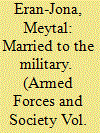

|
|
|
|
|
| Publication |
2011.
|
| Summary/Abstract |
Twenty years after the last research was conducted on military families in the Israel Defense Forces (IDF), this study explores gender arrangements in families of male and female career military personnel as viewed by their civilian spouses. The research objective was to analyze the differences in attitudes toward family life and examine the differences in work-family practices among the IDF's career servicemen and women. The findings indicate that the IDF's heavy demands on career personnel, regardless of gender lead to the construction of family and couple arrangements that deviate from the norm in civilian Israeli-Jewish families of similar characteristics. For the servicemen, this demand creates a ''traditional'' role division model that places the entire burden of family work on their wives; for the servicewomen the same demands create a relatively ''egalitarian'' role division model, by placing more of the burden of ''family chores'' on their husbands.
|
|
|
|
|
|
|
|
|
|
|
|
|
|
|
|
| 8 |
ID:
101330
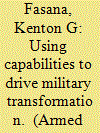

|
|
|
|
|
| Publication |
2011.
|
| Summary/Abstract |
Former cold war nations are grappling with how to transform their militaries in light of new strategic challenges. The implementation of these initiatives often requires a great deal of civil-military interaction. In developing transformational concepts, many of these countries rely on a functional view of capabilities. This article proposes an alternative capabilities model based on the interaction of effects, time, and space and asserts that this model has certain advantages vis-à-vis military transformation. To make its case, this article examines the effectiveness of both capability models in developing transformational concepts. It then uses the case study method to demonstrate the alternative model's practical utility. The results of this analysis indicate that the alternative capabilities model has certain advantages in developing transformational initiatives, integrating these initiatives with defense processes, and communicating these proposals to civilian leaders. The new model is not meant to replace but to complement the functional one.
|
|
|
|
|
|
|
|
|
|
|
|
|
|
|
|
| 9 |
ID:
101332


|
|
|
|
|
| Publication |
2011.
|
| Summary/Abstract |
During the last ten years, the Swedish Armed Forces has undergone a transformation in its shift toward worldwide peacekeeping operations. Subsequently, the Swedish government is moving away from conscription to an all-voluntary recruitment system. This transition may lead to substantial challenges in recruiting new soldiers for the Armed Forces as well as for peacekeeping operations. A key to successful recruitment is understanding what motivates young men and women to participate in peacekeeping operations. This research note addresses questions about what motivated Swedish peacekeeping soldiers to join the 5th mission to Liberia and the 14th mission to Kosovo in 2006. Fabrizio Battistelli's motivation typology, paleomodern, modern, and postmodern, is used in the analysis. The results show that all three motives were represented but that postmodern motives were by far the most common motivator.
|
|
|
|
|
|
|
|
|
|
|
|
|
|
|
|
| 10 |
ID:
101328
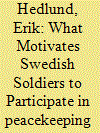

|
|
|
|
|
| Publication |
2011.
|
| Summary/Abstract |
During the last ten years, the Swedish Armed Forces has undergone a transformation in its shift toward worldwide peacekeeping operations. Subsequently, the Swedish government is moving away from conscription to an all-voluntary recruitment system. This transition may lead to substantial challenges in recruiting new soldiers for the Armed Forces as well as for peacekeeping operations. A key to successful recruitment is understanding what motivates young men and women to participate in peacekeeping operations. This research note addresses questions about what motivated Swedish peacekeeping soldiers to join the 5th mission to Liberia and the 14th mission to Kosovo in 2006. Fabrizio Battistelli's motivation typology, paleomodern, modern, and postmodern, is used in the analysis. The results show that all three motives were represented but that postmodern motives were by far the most common motivator.
|
|
|
|
|
|
|
|
|
|
|
|
|
|
|
|
|
|
|
|
|